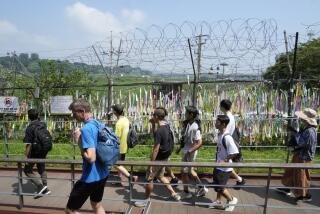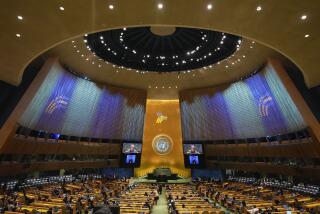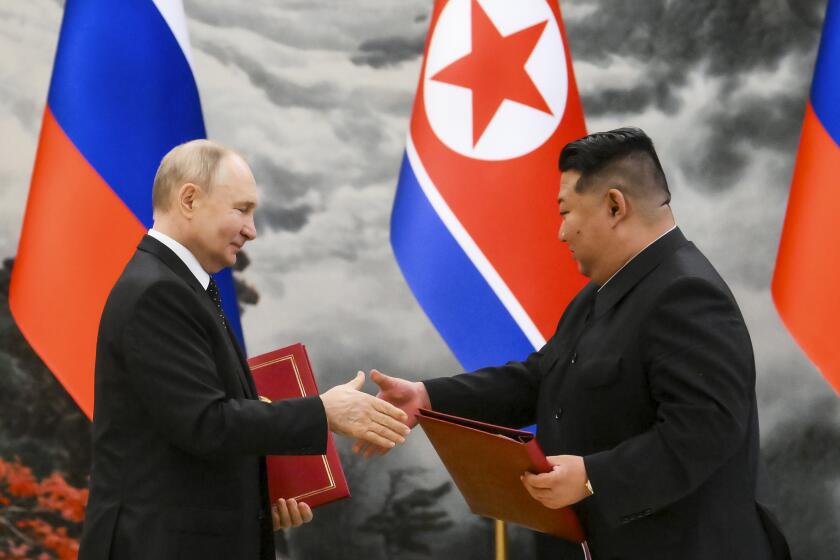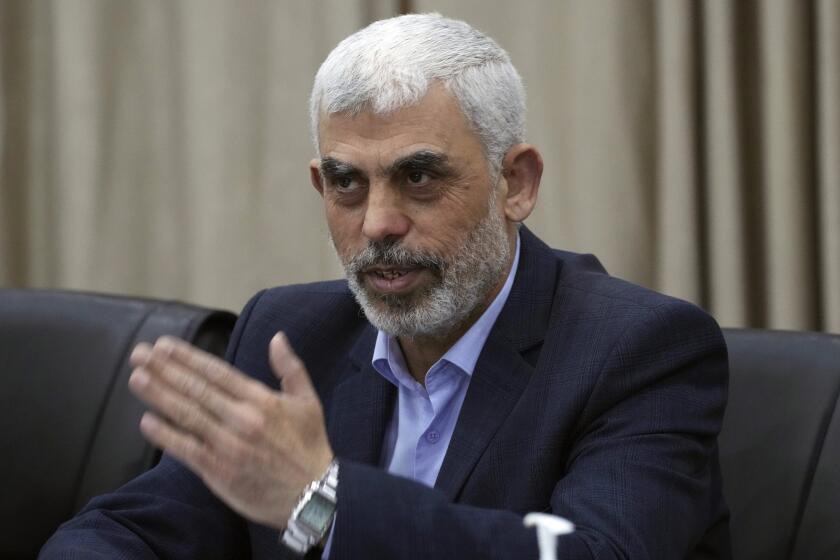Korean Leaders Pledge Steps to Reunification
The leaders of North and South Korea signed a landmark agreement late Wednesday pledging concrete steps toward reunifying their divided peninsula.
The pact, the most sweeping document signed by the two states, redefines the hostile and suspicious relations that still persist in the bisected Korean peninsula a decade after the end of the Cold War.
North Korean leader Kim Jong Il and South Korean President Kim Dae Jung agreed to allow visits around Aug. 15 by an unspecified number of the estimated 1.2 million members of families separated since the Korean War began five decades ago. They also agreed to solve other human rights problems, narrow the gap between their two economies, and speed cultural, athletic, medical and environmental cooperation and exchanges.
Also, the North Korean leader accepted an invitation to visit the South’s capital, Seoul, at “an appropriate time.”
The agreement does not include provisions to reduce tension or deployments of the two countries’ armies, which together have more than 1.7 million soldiers facing one another across a demilitarized zone. Nor does it mention North Korea’s frozen nuclear weapons program, its development and foreign sales of advanced missiles or its demand that the U.S. withdraw its 37,000 troops from South Korea.
The accord does, however, far exceed expectations for what could be accomplished at the first face-to-face meeting between heads of state in the 55 years since the Korean peninsula was divided at the 38th parallel. It was signed on the second day of Kim Dae Jung’s three-day visit to Pyongyang, the North Korean capital, after a private meeting between the two leaders that lasted more than three hours.
The pact was announced after midnight in the Seoul Press Center, where the international media, barred from Pyongyang, were receiving reports from the 50 South Korean reporters who accompanied Kim to Pyongyang. Koreans immediately dubbed it “the June 15 agreement,” noting that it comes 10 days before the 50th anniversary of the outbreak of the Korean War.
In Washington, President Clinton’s comments about the agreement were spare but supportive. “I’m very, very pleased,” he said, calling it a “first step.”
White House Press Secretary Joe Lockhart cited the need for effective follow-up. “It’s very important that they’ve met; it’s very important that they’ve signed this agreement,” Lockhart said. “But I think it’s also very important that a process comes out of this summit that allows them to implement the important work they have agreed to in the last two days.”
Though the agreement does not deal with military questions, it does address issues that both sides consider deeply emotional.
The South Korean president has repeatedly stressed the imperative for allowing families to carry out cross-border visits, particularly for elderly Korean War survivors. Wednesday’s agreement does not specify how many separated family members would be eligible for reunions, or whether they would be allowed to exchange visits to their hometowns, as many here hope.
In 1985, 50 people from each side were allowed to meet briefly in Seoul and Pyongyang, but the visits were then curtailed by the North.
The South also committed itself to resolving the fate of 23 long-imprisoned North Korean spies or sympathizers who have been released but not permitted to return to the North. Wednesday’s deal did not specify details of how many would be repatriated or how.
South Korea appeared ecstatic early today about the agreement. “South-North to Unify Independently,” cried a banner headline in the Joong Ang Daily News. “Declaration of Peace to the World,” the paper’s editorial page said.
North’s Leader Proves a Surprise
For South Koreans, Kim Jong Il has proved to be the biggest surprise of this summit. The potbellied North Korean leader, dressed in a gray Mao-style tunic, has turned out to be voluble and even eloquent, while his guest from the South, not known for reticence at home, has been unusually quiet, according to reports from Pyongyang.
The North’s leader stunned his guests by announcing that he had made previously undisclosed, unofficial visits to China and Indonesia.
“Some Europeans have wondered why I am so reclusive, and some people said it was the first time I appeared in public yesterday at the airport,” he said.
“I am not such a great figure worthy to be called a recluse,” he added, drawing laughter. “President Kim, your visit has liberated me from my reclusive life.”
“Kim Jong Il Shock!” screamed the South Korean headlines as the country grappled with evidence that the North Korean leader--long portrayed as a vulgar, lascivious monster--appears intelligent, well informed and respectful toward his older counterpart. “He’s so Different From the Image We Had,” another headline said.
In Confucian South Korea, it did not go unnoticed that Kim had slowed his walk to match the pace of the older South Korean president, who limps because of a car accident he believes was an attempt on his life during his days as a dissident.
But at the signing ceremony, the North Korean leader did bolster his reputation as a heavy drinker by downing his glass of champagne in a single gulp.
With this seismic shift in perceptions, several South Korean teachers told reporters that they no longer know what to tell their pupils. “The textbook says that North Korea’s goal is to communize the South,” said a teacher quoted by the Chosun Ilbo newspaper. “I don’t know how to explain this.”
So disoriented was the South Korean psyche that one paper even trotted out a psychoanalyst suggesting that Kim Jong Il is treating the 76-year-old South Korean president with such respect because he associated him with his late father, North Korean founder Kim Il Sung.
Kim Jong Il said he had watched television reports from the South about the summit. “I saw how excited the South Koreans were, especially those whose hometowns are in the North, and defectors from the North,” he said. “I saw how many had tears in their eyes waiting for news about their hometowns.”
What stunned South Koreans was Kim’s use of the word “defector,” as the North usually uses the terms “traitors” or “criminals.”
But the South Korean delegation also sought to reassure the North Koreans that capitalism and affluence had not corrupted their traditional Korean values. South Korean first lady Lee Hee Ho had arranged a meeting with the teacher who had taught her mathematics in a girl’s high school in Seoul 60 years ago.
The teacher, Kim Ji Han, had followed her husband to the North after the country was divided in July 1945. The two women were shown holding hands and near tears over a faded sepia photograph from their youth.
Food Shortages Appear to Have Eased
The South Korean president and his wife also toured a children’s performing arts school, where the effectiveness of Communist regimentation was demonstrated by preternaturally perfect performances by adorable red-cheeked and well nourished-looking North Korean children. By some estimates, 2 million North Koreans are believed to have died during the wrenching famines of the 1990s, and the food situation is believed to have improved largely thanks to foreign aid.
Kim Dae Jung was quoted as telling his North Korean counterpart that the information era makes it more vital than ever for the two Koreas to unite and compete as one in the global economy. He also called on the North to improve relations with the United States and Japan.
The North had stressed the importance of managing reunification without the interference of the foreign powers that have controlled the peninsula’s fate for most of the last century. In apparent deference to Pyongyang, the pact specifies that “the South and North have agreed to resolve the question of reunification independently and through the joint efforts of the Korean people.”
It was not clear, however, that the two sides share the same definition of “reunification.”
The South’s Kim, a longtime scholar of North Korea, has laid out his three-phase plan for reunification in a lengthy book and numerous articles and speeches. In his scheme, the first phase, lasting about 10 years, would involve forming a confederation leaving the two independent governments as they are now.
The second phase would be a federation with a central government responsible for foreign affairs, defense and key domestic policies, but with autonomous governments in the North and South that would deal with regional domestic policies. Kim envisions this eventually leading to complete reunification.
The agreement signed Wednesday states, “There is a common element in the South’s proposal for a confederation and the North’s proposal for a loose form of federation. The South and the North agreed to promote reunification through these frameworks.”
However, there was no word from the delegation in Pyongyang elucidating Kim Jong Il’s current position concerning the matter.
The two Kims toasted each other with French Pouilly-Fuisse white wine at a luncheon today, after which the South Korean leader was expected to fly home.
*
Times staff writer James Gerstenzang in Washington and researcher Chi Jung Nam in Seoul contributed to this report.
For complete coverage of the summit in Pyongyang, visit The Times’ Web site at https://www.latimes.com/korea.
*
MISSILE SHIELD DEBATE
Kim Jong Il’s apparent rationality may weaken the case for a U.S. missile defense system. A9
* THE AGREEMENT: A9
More to Read
Sign up for Essential California
The most important California stories and recommendations in your inbox every morning.
You may occasionally receive promotional content from the Los Angeles Times.










